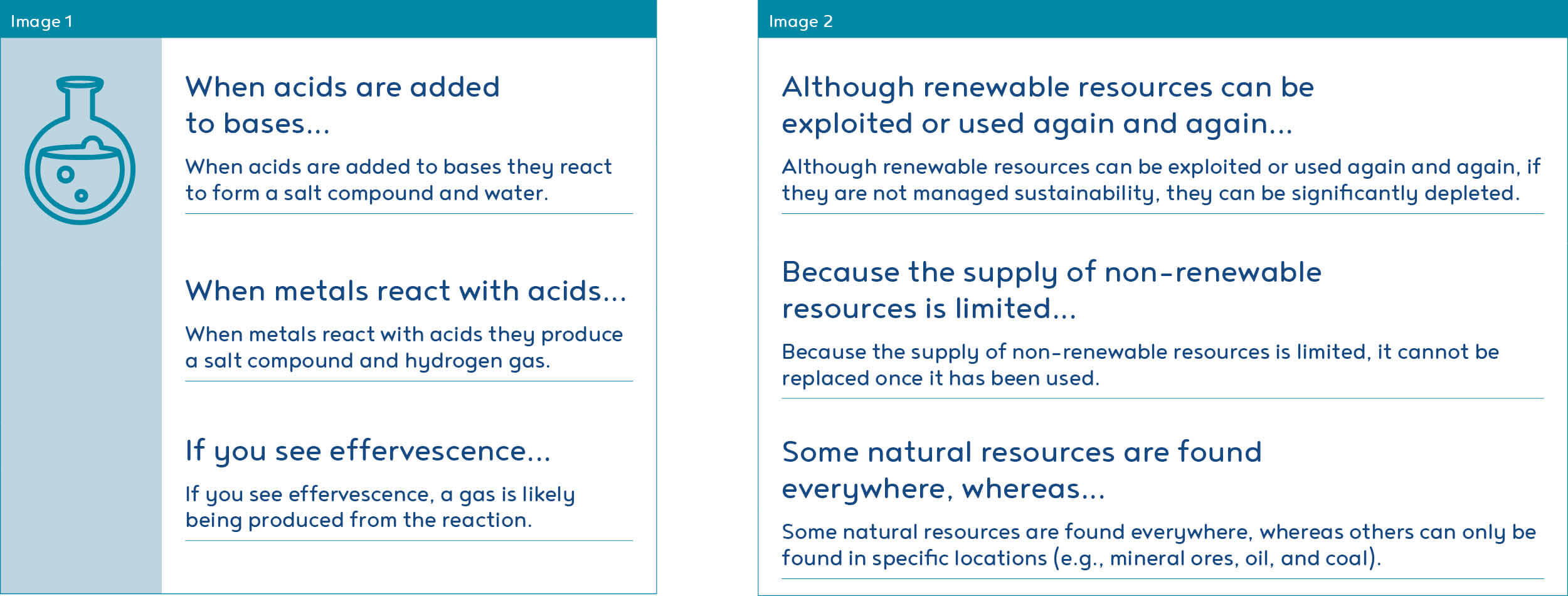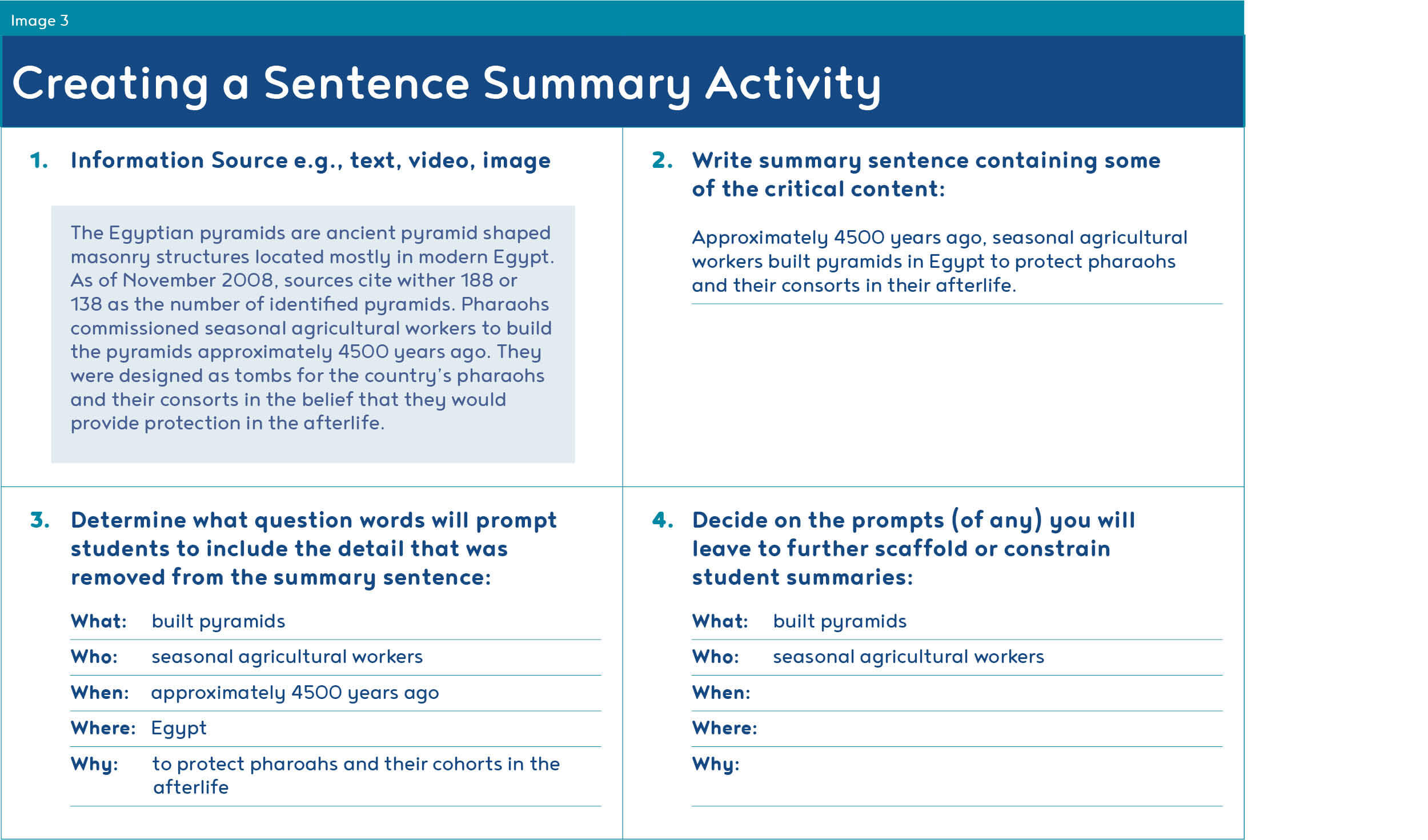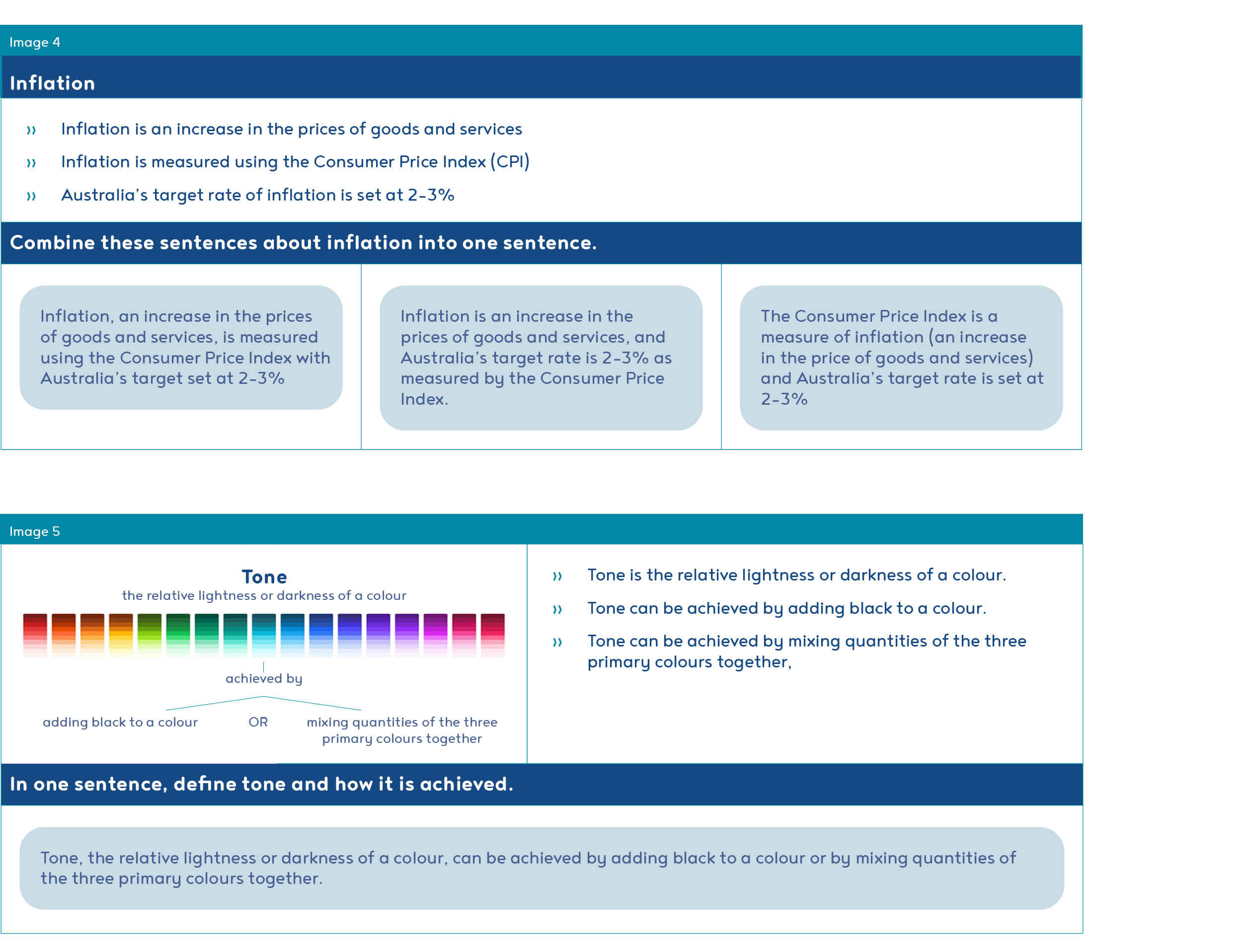by Ingrid Sealey, CEO & Founder of Teach Well
First published in LDA Bulletin, Volume 56, No 1, April 2024 Download PDFOne of the many challenges for teachers is supporting students to master conceptual knowledge. Often this knowledge requires students to think about several key ideas and to understand the relationships between those ideas. This conceptual knowledge could be, for example, understanding the roles of women in medieval society, the factors leading the British Empire to establish penal colonies in Australia, or the parts and functions of the organelles in animal cells. What makes this content challenging to teach is the complexity of the ideas and knowledge. Techniques that work well for teaching complex skills (such as gradually releasing students through an I Do, We Do, You Do) are not always well suited to this kind of information. Wanting students to learn this knowledge while simultaneously asking them to demonstrate it to us through a complex skill, such as essay writing (even if we do gradually release essay writing skills), can lead to cognitive overload. At Teach Well, we encourage teachers to help manage this complexity for our students by focusing on the ideas and knowledge first, before we get students to take on trickier forms of expression.
So, how should we best help students think about these key ideas and relationships? How can effective sentence-level writing instruction help position students to better comprehend, think about, and express relationships between key concepts?
After working with more than 3,000 teachers and leaders across Kindergarten (WA; aged 3.5-4.5 years) to Year 12 classrooms, in almost all curriculum subjects, we have seen the power of arming teachers with a small set of sentence-level writing activities. The power of these activities is their wide applicability and flexibility — they can be used to generate thinking by students about almost any conceptual knowledge — and the accumulated evidence demonstrates that these activities can support both conceptual knowledge and improve student expression and writing.
This article shares some of the experience of this hands-on work with educators. There are some excellent ‘how to’ guides and resources available to support teachers to adopt these activities. The Australian Education Research Organisation (AERO) has produced a suite of resources including guides on sentence combining and various sentence structures referencing the broader literature (AERO, 2022, 2023a, 2023b, 2023c, McLean & Griffiths, 2022). Many of our teachers have also found The Writing Revolution (Hochman & Wexler, 2017) to be an excellent support manual, and the four activities in this article are included in the book. As such, this article will focus on some of Teach Well’s learnings about how these activities can be best brought to life. The four sentence- level writing activities discussed will include:
- Sentence stems
- Sentence expansion
- Sentence summarising
- Sentence combining
Our Experience – Every educator is well placed to give these activities a go!
Educators don’t need to be experts in everything to do with English grammar to make the most of these activities. Teachers of almost every subject, from Physical Education to Religious Education and certainly primary classroom teachers, find having a small, robust, frequently used set of activities to be very helpful. The four techniques below have stood the test of thousands of Australian classrooms, increasing student learning and engagement. No grammar experts are required – you will build your skill level with your students as you use these activities.
When should I consider using these activities?
- During initial instruction and in lessons with a lot of conceptual information or facts. Students build their conceptual knowledge in a topic by thinking intentionally about the key relationships and ideas.
- In review activities. Each of the activities asks for varying levels of information retrieval and this can strengthen the encoding of key concepts and ideas.
Sentence Stems
Sentence stem activities can be crafted to fit almost all conceptual content. All subjects and year levels have big ideas with relationships to explore. Sentence stem activities are an ideal strategy for deepening student understanding of this type of content.
In a sentence stem activity, the teacher provides the first clause of a complex or compound sentence and the conjunction (signaling the relationship between ideas). Students then generate the second clause and write the complete sentence.
Image 1 and image 2 are examples from Science and Humanities and Social Sciences, which show how students can be asked to consider different key relationships, with the subordinating conjunction determining the relationship students should focus on.
It can be helpful to think about relationships in the information you are presenting to students. Are the ideas unfolding chronologically? Or are there interdependencies or conditions that are required for some ideas to hold true? Are there hierarchical relationships or contrasting positions?
Our teachers often find it helpful to have a list of subordinating conjunctions handy whilst constructing stem activities to expose their students to a variety of vocabulary and relationships.

Top tips for sentence stems
- There’s no magic number of sentences in a sentence stem activity. Even just using one sentence and varying the range of conjunctions you use over time can increase student understanding of your content.
- Be sure to include a subordinating conjunction in your stems (at the beginning or the end of the stem). The subordinating conjunction highlights the relationship between the big ideas. Without the conjunction, this can become a less powerful cloze activity.
- Do use these activities verbally with students. If time is short, have students pair-share and prepare their answers before calling on some non-volunteers to share their full-sentence answers orally.
Sentence Expansion
Have you ever marked student assessments and found your feedback to every second student is to “add more detail”, only to find that those same students generally don’t add more detail in the next round of work they submit?
This is one of the most common challenges for teachers, particularly as students move through upper primary and secondary school. Sentence expansion activities are an excellent vehicle for explicitly teaching, modelling, and gradually releasing the skill of adding detail to a sentence.
In a sentence expansion activity, students add detail to a simple sentence, drawing from a given source or previous learning, with the teacher directing them to the critical content through questions or question words.
In table 1, taken from a primary history lesson, the teacher has students retrieve critical information from the lesson by asking questions to probe for more detail, scaffolding and effectively guiding students through writing an expanded sentence about the First Fleet arriving in Sydney Cove.
Although these types of activities are common in early childhood classrooms, particularly to first introduce students to key syntactic structures, they remain an excellent vehicle for more open retrieval of information when working with older students.
For example, in this secondary Religious Education lesson on the Diocletian Persecution (table 2), students are asked to retrieve multiple key ideas to expand the sentence “They persecuted Christians.” before constructing their more detailed sentence.

Sentence Summarising
In a sentence summarising activity, teachers guide students to create high-quality, structured summaries using question words to direct them to the critical content.
When we summarise, we identify the essence of the information before us. Yet, we also know that novice learners often misunderstand what is considered to be critical content, making summarising very difficult. I’m sure that teachers have all experienced when students’ summaries of text are often nearly as long as the original text themselves!
Sentence summarising activities help to guide students towards including the critical content in their sentences, and to help them order their thinking. This is especially powerful during the initial stages of instruction when students are encountering multiple new ideas, and also during further instruction when we can expose students to additional layers of information and support them to read more complex texts.
Beyond the direct benefits for reading comprehension, the ability to summarise is essential for writing effective paragraphs (Hochman & Wexler, 2017; McLean & Griffiths, 2022; Sedita, 2019). Such sentences serve as ideal topic or concluding sentences for the commonly used TEEL (or other) paragraph writing structure in extended writing tasks. Image 3 is a slide taken from our Masterclass Course for Years 3-10 teachers, which explains the four steps required to create an effective sentence summary activity.

Sentence Combining
The impact of learning to combine sentences on student writing has been highlighted by literature reviews into effective writing instruction (Graham & Hebert, 2010; McLean & Griffiths, 2022; Sedita, 2019). In these activities, students combine shorter sentences of critical content to improve sentence quality, complexity and variety.
Sentence combining is one of the most studied techniques for improving student writing, even if it has not been adopted widely in classrooms. One reason for this might be that teaching sentence combining can be surprisingly tricky. Teachers are experts in their domains of knowledge and the curse of expertise can make the task of combining sentences appear deceptively simple. Consequently, teachers may find it difficult to explain to students exactly what they are doing and the decisions they are making, as they model combining sentences together. Many students are familiar with conjunctions such as ‘and’, ‘or’, or ‘but’ but they don’t always find it straightforward to apply this knowledge when combining sentences.
Let’s have a look at two examples using different source materials to practice sentence combining.
In the first example (image 4), the teacher used a more traditional approach to sentence combining where students were provided with three sentences about inflation and tasked to create one combined sentence. In this second example (image 5), an art teacher uses three sentences and a graphic organiser with visuals to support students to create a combined sentence about the concept of ‘tone’.

Our Experience
Introduce these activities in lessons, reviews and practice
It can be more straight-forward to initially introduce sentence-level writing during lessons before using them in review activities. During lessons, teachers have more time to guide practice and gradually release the writing skill and this ensures a higher success rate for their students. However, once teachers have guided a few examples in their lessons, sentence-level writing can often be incorporated efficiently into daily, weekly, or monthly reviews and practice to help students focus on retrieving key information and practice constructing well-written sentences using this key information.
Top Tips for Sentence Combining
- Model variations of sentence combining.
- Prepare a ‘think aloud’ to accompany modelled examples. It’s worth preparing this to explain why you made the choices of conjunctions and structure for your modelled examples.
- Consider providing a table of conjunctions for students to select from, at least initially. Encourage students to identify the relationships between the sentences and select appropriate conjunctions to match (or expand beyond the limited conjunctions that students favour).
- AERO’s Sentence Combining guide is excellent and outlines many different types of combining. Teachers have found it helpful to introduce sentence combining in small steps with lots of practice for each so that students can internalise the processes.
Acknowledgement
I would like to acknowledge and thank the Teach Well team for their contributions to the examples and the collation of teacher experiences included in this article.
Some take-home messages for school leaders and teachers
Sentence-level writing activities are powerful for enhancing students’ ability to comprehend and express the relationships between ideas. These activities should always be delivered with participation tactics and checks for understanding. Teachers should use ‘think alouds’ and explain to students what they are doing when they model with students. It is always better when introducing these activities to provide more guidance than is needed rather than too little guidance. If students have success with the task, they will be more motivated to try the task with less support next time. That is certainly easier than taking a student who was unsuccessful the first time and needing to re-engage them with the task.
References
- Australian Education Research Organisation. (2022). Sentence combining: Improving sentence quality, complexity and variety. https://www.edresearch.edu.au/sites/default/ files/2022-04/aero-sentence-combining-prac- tice-guide-190422.pdf
- Australian Education Research Organisation. (2023a). Simple sentences: Are not necessarily simple! https://www.edresearch.edu.au/sites/default/ files/2023-05/aero-writing-guide-simple-sen- tences-aa.pdf
- Australian Education Research Organisation. (2023b). Complex sentences: Creating agility and depth in your writing. https://www.edresearch.edu.au/sites/default/ files/2023-05/aero-writing-guide-complex-sen- tences-aa.pdf
- Australian Education Research Organisation. (2023c). Compound sentences: Adding interest. https://www.edresearch.edu.au/sites/default/ files/2023-05/aero-writing-guide-complex-sen- tences-aa.pdf
- Graham, S. & Hebert, M.A. (2010). Writing to read: Evidence for how writing can improve reading. A Carnegie Corporation Time to Act Report. Washington, DC: Alliance for Excellent Education.
- Hochman, J., & Wexler, N. (2017). The Writing Revolution: A Guide to Advancing Thinking Through Writing in All Subjects and Grades. San Francisco, CA: Jossey- Bass, a Wiley Brand.
- McLean, E., & Griffiths, K. (2022). Writing and writing instruction: An overview of the literature. Australian Education Research Organisation. https://www.edresearch.edu.au/sites/default/ files/2022-02/writing-instruction-literature-re- view.pdf
- Sedita, J. (2019). The Writing Rope: The strands that are woven into skilled writing. Rowley, MA: Keys to Literacy.
About the Author
Ingrid Sealey is Founder and CEO of Teach Well, a certified social enterprise. In recognition of Teach Well’s impact in improving outcomes for students across Australia, Ingrid won the 2023 Cartier Women’s Initiative Award for the Oceania region and the national 2021 Westpac Social Change Fellowship. Prior to founding Teach Well, Ingrid was recognised as a 40Under40 Winner for her work leading the Fogarty Foundation’s not-for-profit school improvement program with over 80+ schools in complex communities.
